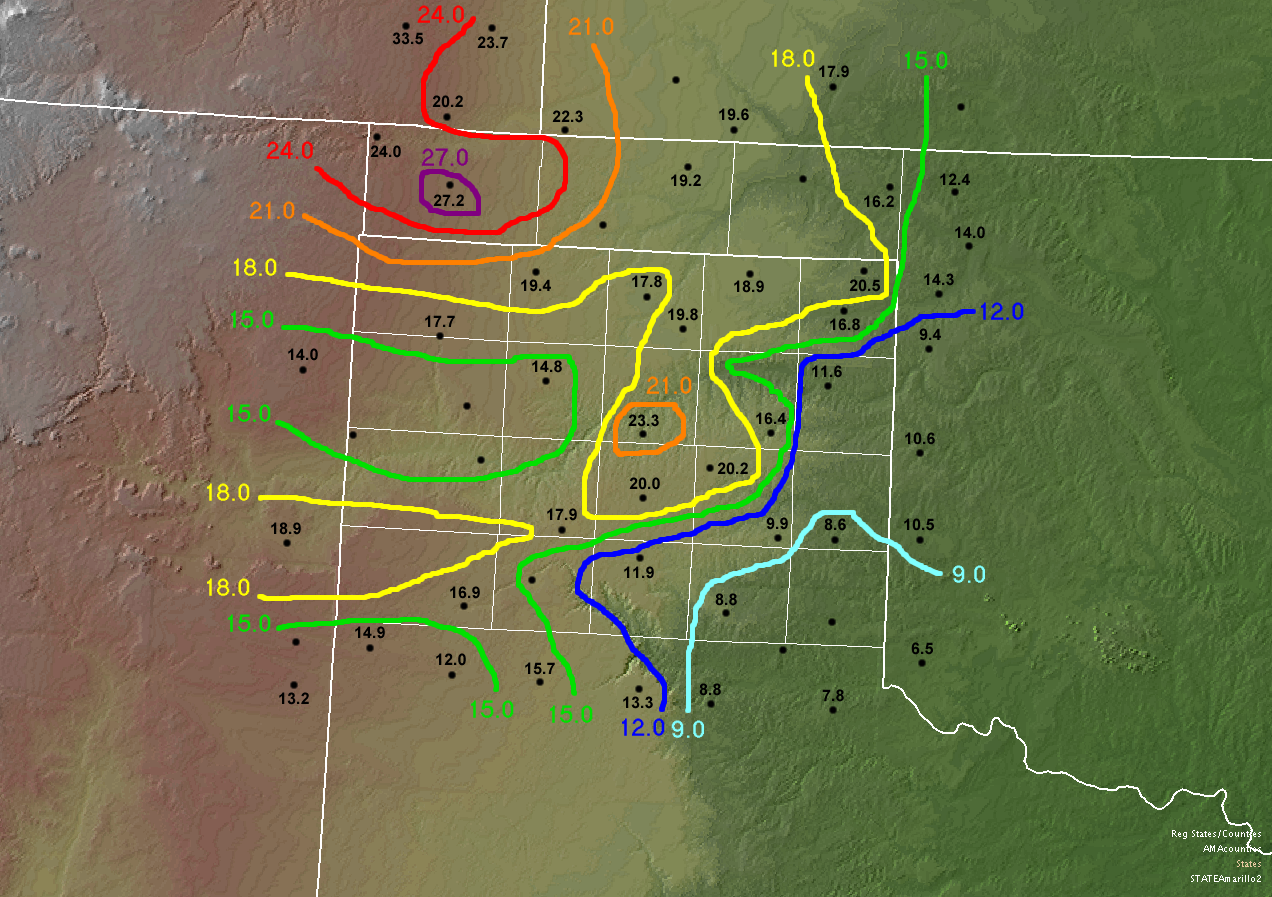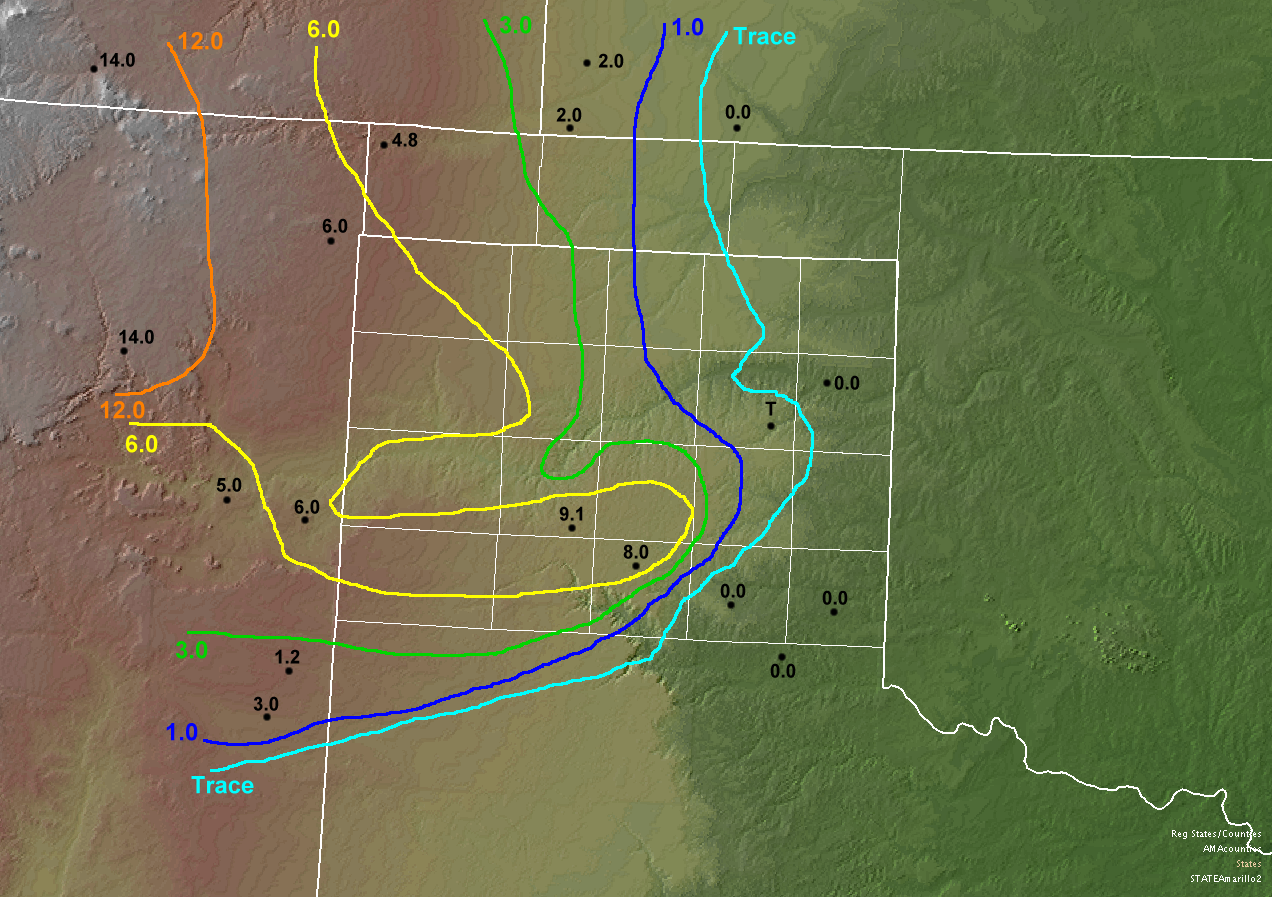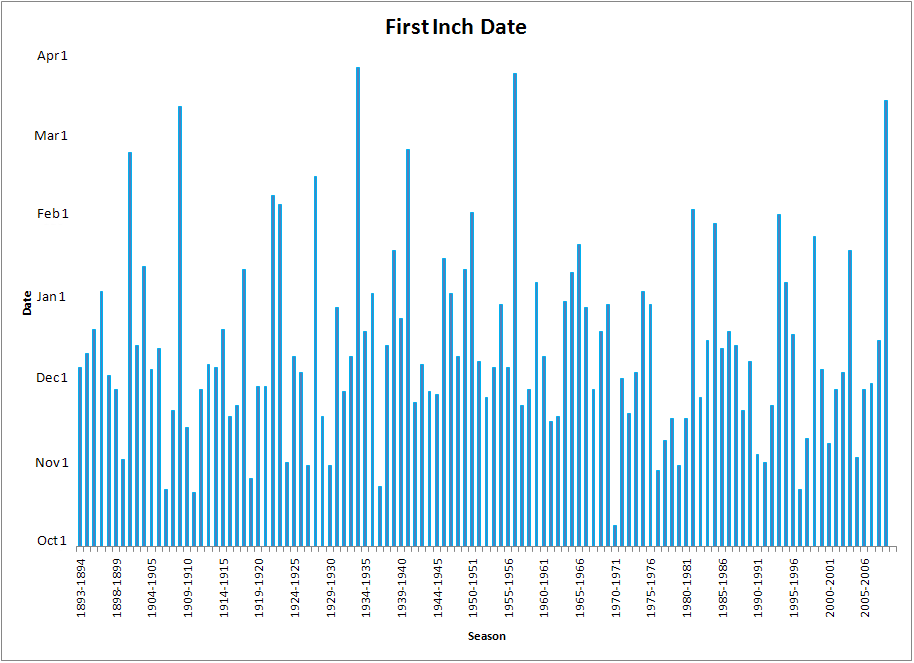
Thunderstorms ahead of an approaching cold front will impact much of the Central U.S. through Tuesday. Severe thunderstorms and flash flooding are forecast for portions of the central/southern Plains and the Mississippi, Ohio, and Tennessee Valleys. Meanwhile, dangerous waves and rip currents will impact portions of the East Coast as tropical activity increases in the Atlantic. Read More >
by Chris A. Kimble
The Texas and Oklahoma Panhandles on average receive much more snowfall than areas further to the east. This is mainly a factor of the higher terrain. Amarillo sits at about 3700 feet above sea level, while Oklahoma City is only about 1300 feet above sea level. The higher elevation keeps temperatures cooler and allows snow to fall during a wider range of months. On this page you will find answers to several commonly asked questions about snowfall in the Panhandles.
1. What is the average annual snowfall?
2. What is the earliest measurable snowfall?
3. What is the latest measurable snowfall?
4. When does the first inch of snow usually fall?
5. What is the greatest amount of snow to fall in a season?
6. What is the least amount of snow to fall in a season?
1. What is the average annual snowfall?
Snowfall in the Texas and Oklahoma Panhandles varies greatly and is highly dependent upon elevation. Generally snowfall on the higher terrain of the Llano Estacado to the west of the Caprock Escarpment is greater than areas farther east due to the availability of colder air. However, other factors like the availability of moisture also impact the annual snowfall. Areas further east generally are more moist and can produce heavy snowfall totals if enough cold air is also available. Amarillo averages 17.9 inches of snow annually. Below is a map of average annual snowfall based on the period 1971-2000. Observations were taken primarily by volunteer cooperative weather observers.
Average Annual Snowfall (1971-2000)

2. What is the earliest measurable snowfall?
The earliest measurable snowfall in Amarillo occurred on September 29, 1984 when 0.3 inches of snow was recorded. Other years have also seen snow fall in the month of September, but the snow melted as it fell and never accumulated to more than one tenth of an inch. The earliest snowfall in the Texas Panhandle occurred at Stratford on September 27, 1936 when 1.0 inches fell. The earliest snowfall in the Oklahoma Panhandle occurred at Kenton on September 18, 1971 when 3.0 inches fell. Below are snowfall maps after the only three storms to bring snowfall to several locations in the Panhandles.
Snow has also fallen at Kenton, OK a few other times in September, but was not recorded in any other location in the Panhandles. The September dates that snow was only measured in Kenton, OK are September 21, 1995 (0.5 inches) and September 18, 1971 (3.0 inches).
3. What is the latest measurable snowfall?
The latest measurable snowfall in Amarillo (and the Texas Panhandle) occurred on May 5-6, 1917 when 9.1 inches fell. Snow has fallen in the Panhandles on several other occasions in the month of May, but most recently on May 2-3, 2005. On this day 4.7 inches fell in Amarillo. The maps below are of snowfall totals from the May 1917 snowfall and the more recent May 2005 snowfall.
May 5-6, 1917 (observations are relatively sparse)

The latest measurable snowfall in the Oklahoma Panhandle occurred on May 20-21, 1931 in Kenton when 1.2 inches fell. Other May snowfalls have occurred across the Texas and Oklahoma Panhandles and are listed in the table below.
|
DATE |
LOCATION |
MOST SNOW |
| May 1, 1954 | Trace of snow observed in the northwestern Texas Panhandle and most of the Oklahoma Panhandle | 0.2 (Kenton, OK) |
| May 1-2, 1929 | Sporadic trace amounts of snow across most of region. Accumulations in western Panhandles including Kenton (0.5 inches) and Vega (1.0 inches). | 1.0 (Vega, TX) |
| May 2-3, 2005 | Snow fell on the higher terrain of the central Texas Panhandle and the western Oklahoma Panhandle. The heaviest snow was recorded in a band near Interstate 40 from Vega to Amarillo to Pampa. The most snow in the Oklahoma Panhandle fell in Boise City (3.0 inches). | 5.0 (Vega, TX) 5.0 (Pampa, TX) |
| May 2-3, 1978 | Primarily northern Texas Panhandle and Oklahoma Panhandle. Light amounts as far south as Amarillo (0.5 inches) and Borger (2.7 inches). Heavier amounts in northwest including Dalhart (6.5 inches), Conlen (10.6 inches), and Gruver (5.5 inches). Amounts as high as 12 inches recorded at Boise City and Stratford. | 12.0 (Stratford, TX) 12.0 (Boise City, OK) |
| May 3, 1990 | Mainly the western Oklahoma Panhandle, but a trace of snow was observed as far south as Dalhart, TX. | 5.1 (Kenton, OK) |
| May 3-4, 1979 | Primarily northwestern Texas Panhandle although a trace of snow was observed as far east as Perryton and as far south as Borger. | 3.0 (Dalhart, TX) |
| May 3-4, 1935 | Heaviest snow fell in central and western Texas Panhandle. Amarillo received 2.2 inches and a trace of snow was observed as far east as Canadian. The most snow in the Oklahoma Panhandle fell at Boise City (2.0 inches). | 3.0 (Vega, TX) |
| May 4, 1933 | Extreme western Oklahoma Panhandle although a trace of snow was observed as far south as Stratford, TX. | 0.5 (Kenton, OK) |
| May 5-6, 1917 | Snow fell across western and central sections of the Texas and Oklahoma Panhandles. Records are sparse, but the most snow fell in a band near present-day Interstate 40. The most snow recorded fell in Amarillo (9.1 inches) with a trace observed as far east as Miami. The only snowfall report from the Oklahoma Panhandle was from Kenton (4.8 inches). | 9.1 (Amarillo, TX) |
| May 6, 1915 | Western and central Oklahoma Panhandle | 4.0 (Goodwell, OK) |
| May 12, 1953 | Accumulations in western Oklahoma Panhandle. Trace of snow observed as far south as Amarillo and as far east as Spearman, TX and Beaver, OK. | 3.0 (Boise City, OK) |
| May 13, 1912 | Western Oklahoma Panhandle | 4.0 (Kenton, OK) |
| May 20-21, 1931 | Western Oklahoma Panhandle | 1.2 (Kenton, OK) |
4. When does the first inch of snow usually fall?
In Amarillo, the average date of the first inch of snowfall in a season is December 5. It has occurred as early as October 8 (2.9 inches in 1970). Since 1893 there have only been two seasons which did not record a day of 1.0 inches of snowfall or higher (1901-02 and 1949-50). Not surprisingly, the snowiest seasons in Amarillo all tend to have early snow events. For the snowiest 10% of seasons, all received the first inch of snow by December 19. The dates of the first inch of snow are displayed in the chart below.
Actual Dates of First Inch of Snow

The first inch falls in October on average about once per decade (but has not happened since 1996). The first inch of snow falls by November 30 about 40% of the time. However, the decade of the 2000s had 5 first snows in November which is more than any other decade. In fact, half of all early November snowfalls (4 of 8 total) have occurred since 1990. The first inch of snow falls after January 1 only about 23% of the time.
If the first inch of snow has not fallen by March 1, 33% of seasons did not receive an inch of snow at all (1901-02, 1949-50). However, the other 67% of these seasons endured heavy March snowfalls or blizzards with total snowfall accumulations of at least 11.0 inches (12.5 March 1909, 21.5 March 1934, 11.1 March 1957, 12.6 March 2009).
5. What is the greatest amount of snow to fall in a season?
| RANK | SEASON | SNOWFALL (INCHES) |
| 1 | 1918-1919 | 51.5 |
| 2 | 1982-1983 | 47.9 |
| 3 | 2000-2001 | 46.3 |
| 4 | 1923-1924 | 42.0 |
| 5 | 1904-1905 | 41.6 |
| 6 | 1931-1932 | 41.0 |
| 7 | 2004-2005 | 40.2 |
| 7 | 1911-1912 | 40.2 |
| 9 | 1902-1903 | 38.6 |
| 9 | 1894-1895 | 38.6 |
6. What is the least amount of snow to fall in a season?
| RANK | SEASON | SNOWFALL (INCHES) |
| 1 | 1949-1950 | 0.1 |
| 2 | 1901-1902 | 0.5 |
| 3 | 1954-1955 | 2.3 |
| 3 | 1903-1904 | 2.3 |
| 5 | 2005-2006 | 2.5 |
| 6 | 1966-1967 | 3.3 |
| 7 | 1953-1954 | 6.3 |
| 8 | 1975-1976 | 6.4 |
| 8 | 1950-1951 | 6.4 |
| 10 | 1991-1992 | 6.7 |
| 10 | 1973-1974 | 6.7 |